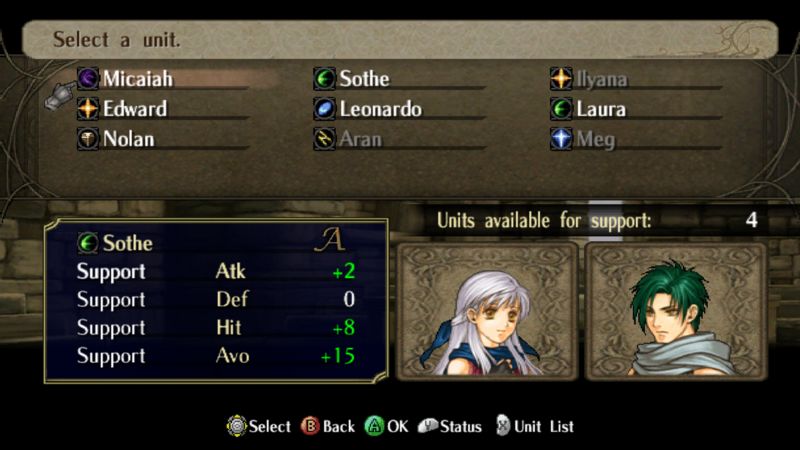Part 10: (Game Mechanics) Fuckin' supports, how do they work?
Let's Talk About Game Mechanics!Episode the Third: Fuckin' supports, how do they work?
Very simply!
The actual method of establishing supports is a little different in Radiant Dawn compared to previous Fire Emblems; you can pair anyone with anyone as long as they've fought together enough, and you can erase a support and start a new one at any time, and the process is no longer associated with an arc of bonding conversations.
The rest is unchanged; two characters who have a support relationship with eachother will receive bonuses to certain stats when standing within 3 map squares of eachother. The actual mechanics of how support bonuses are calculated are pretty simple.

Remember Affinities? They've been mentioned in passing a few times before this point.
Every character has their own affinity (it can't be changed). Every affinity has its own set of benefits that it contributes to a support relationship:
Fire: Atk +0.5, Hit +2.5
Water: Atk +0.5, Def +0.5
Wind: Hit +2.5, Avoid +2.5
Thunder: Def +0.5, Avoid +2.5
Heaven: Hit +9
Earth: Avoid +7.5
Light: Def +0.5, Hit +2.5
Dark: Atk +0.5, Avoid +2.5
For a basic (C-Rank) support, simply take the bonuses associated with the affinities of each character and add them together, and round the results appropriately to the nearest integer. Both characters get both bonuses, and bonuses to the same stats stack. For example, we've already seen Edward and Nolan's support; Def +0.5, Hit +2.5 (light), Avoid +7.5 (earth).
For a B-Rank support, add double the bonuses. For an A-Rank support, add triple.
But! What's a little more complicated is the mechanics of how the game defines "fought together enough".
What the game doesn't tell you is that every individual character relationship has a defined rate at which its "support points" grow. There are five distinct speeds, and they're distributed in what's actually the way you might expect it logically to be; characters who really like eachother tend to progress faster and characters who don't will progress slower. There are exceptions, and some relationships are open to interpretation as to friendship, but you can usually hazard a guess. The support point value is shared between the two characters in the relationship. The characters don't gain points; their relationship does.
The important part, though, is this. There are five actions that influence support points.
1) Shoving. When supported units shove eachother, they gain a few support points. Serenes Forest claims (with a "not thoroughly tested" disclaimer) that the slowest supports will actually progress backwards a little when units shove eachother, so make of that what you will.
2) Being next to (not near) eachother. When supported units start a turn on adjacent squares they gain a few points.
3) Healing. When supported units heal eachother, they gain a few points.
4) Carrying. When one supported unit begins a turn carrying the other (a feature we've yet to see in the LP, but whatever), they gain a good few points.
5) Being selected. If both supported units are selected to be in your team at the start of a chapter, they gain a whole lot of points.
If you want to build a support, your best bet is to keep selecting the units for your team and have them start turns adjacent. For most characters, two or three battles of this should be enough to gain a rank. Naturally, all these numbers are invisible.
There's also a special kind of support called a Bond Support, which I believe we've mentioned already; certain units with close relationships (friendly or romantic) get +10 Crit when directly adjacent. You can't manipulate Bond Supports at all; units either have them or don't. One exception; if you're importing data from Path of Radiance and two units had an A-Rank support, they will have a Bond support in Radiant Dawn.